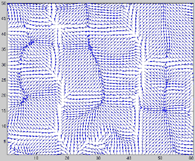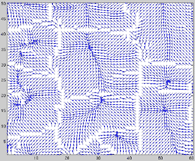|
Our skeletonization algorithm is based on the
anisotropic vector diffusion. We first compute
and diffuse the gradient vector field, and then
calculate a map, called skeleton magnitude map,
by summing up all the outgoing vectors minus all
the incoming vectors, at each voxel. The obtained
map gives a magnitude (or, possibility) for each
voxel being on the skeletons. From the skeleton
magnitude map, we then trace the skeletons by,
for example, Canny¡¯s edge tracing algorithm or
other ridge tracing methods. The problem to be
solved is the proof of the connectivity, the
thickness, and the topology-preservation of
the obtained skeletons.






Fig. 5 Top: original density map; gradient vector fields
(iso- & aniso-)
Bottom: skeleton magnitude maps (iso- & aniso-);
skeleton tracing


Fig. 6 The skeletons of the bullfrog hair bundle tip link.
Left: overall dataset. Right: skeletons of a sub-volume
|